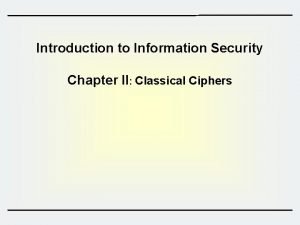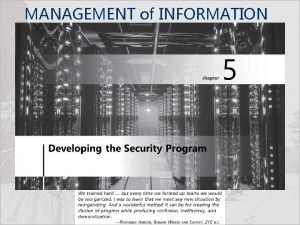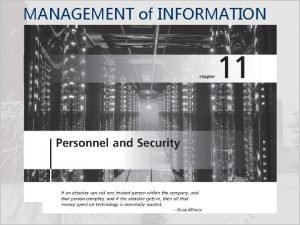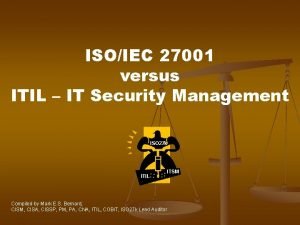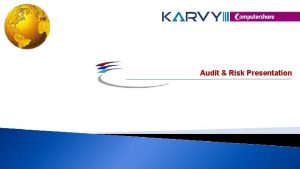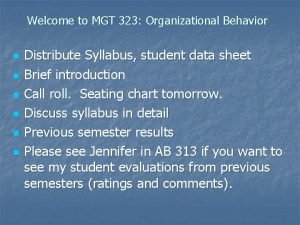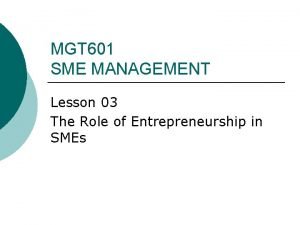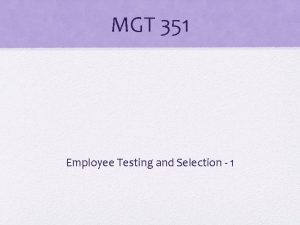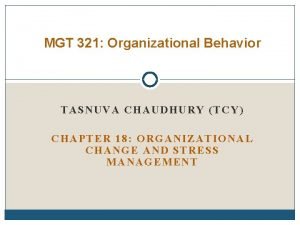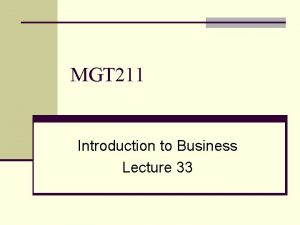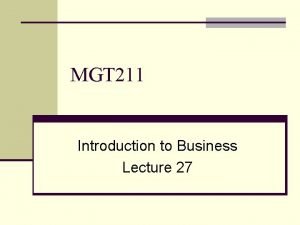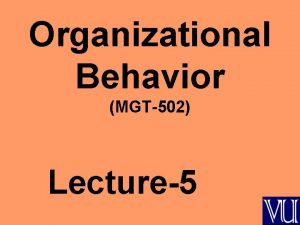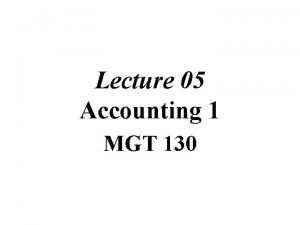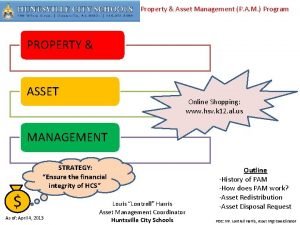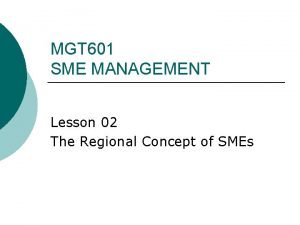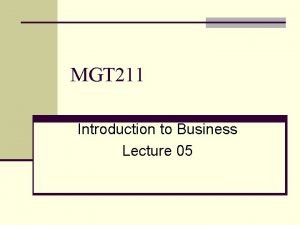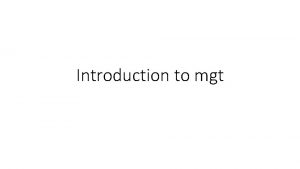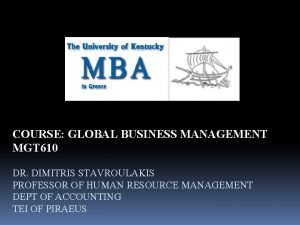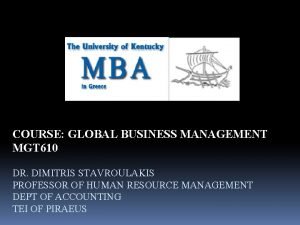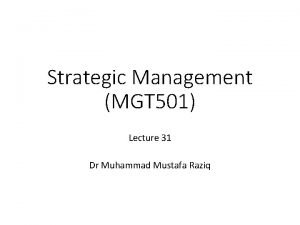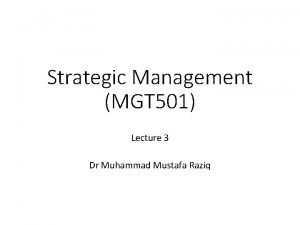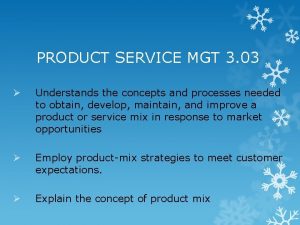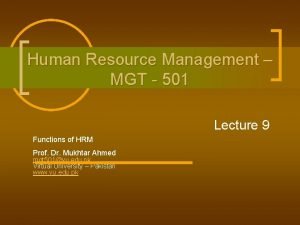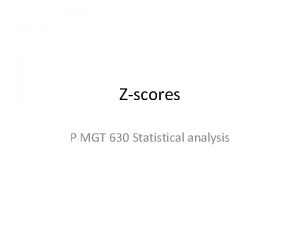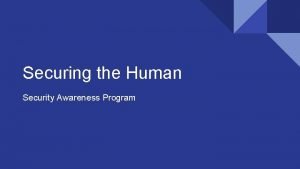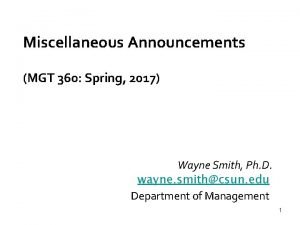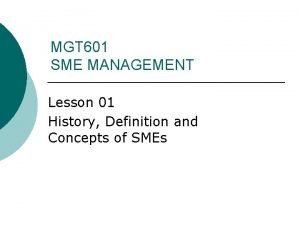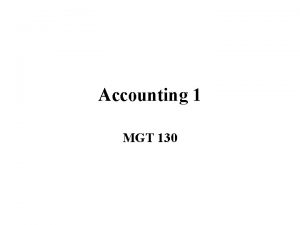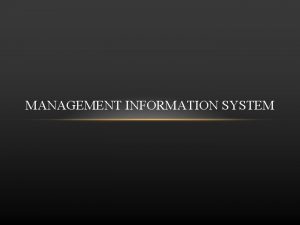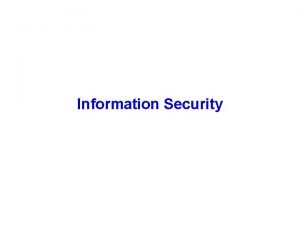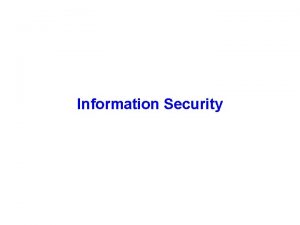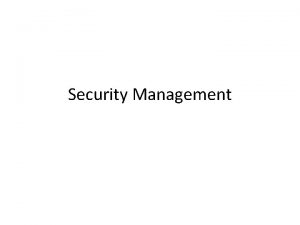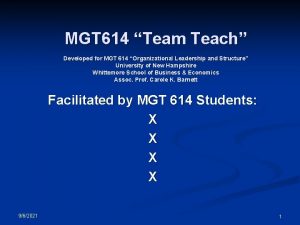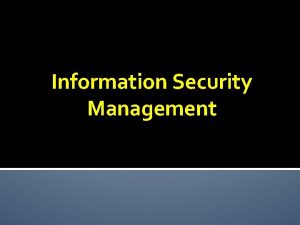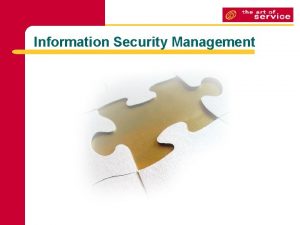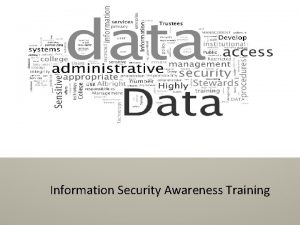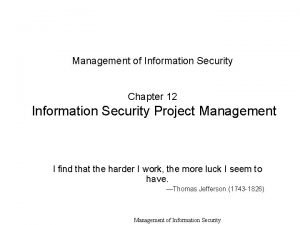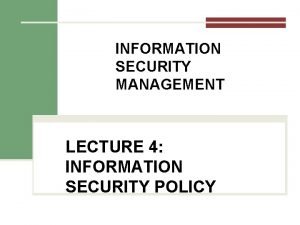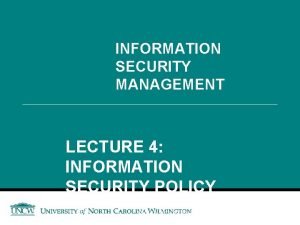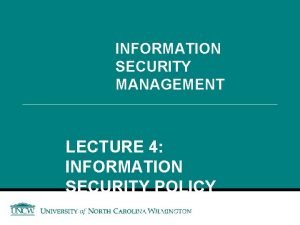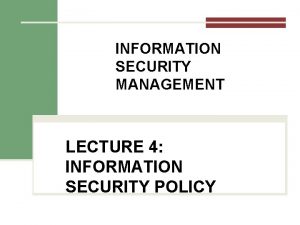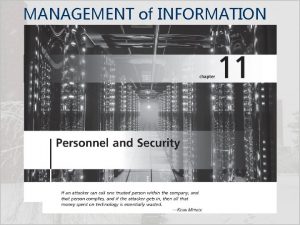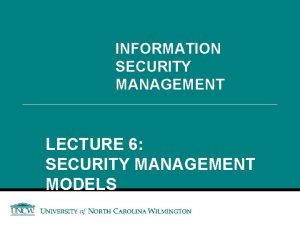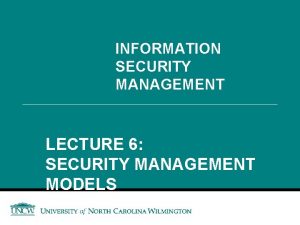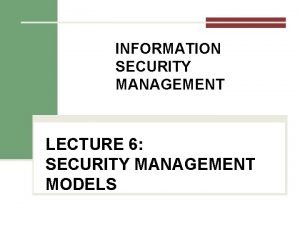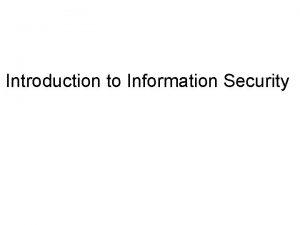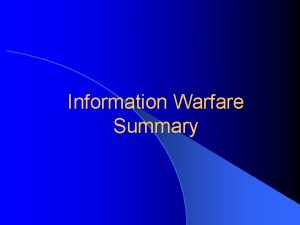INFORMATION SECURITY MANAGEMENT INTRODUCTION TO THE MGT OF
















































- Slides: 48

INFORMATION SECURITY MANAGEMENT INTRODUCTION TO THE MGT OF INFORMATION SECURITY

Course Outline – Topics Covered n Planning for Security and Contingencies n Information Security Policy n Developing Security Programs n Security Management Models n Risk Management Identifying n Assessing n Controlling n

Course Outline – Topics Covered n Protection Mechanism n Personnel and Security n Law and Ethics n Security and the Cloud

Classroom Procedures Most classes will contain the following components: Current Events n Lectures n Case Studies n Project Presentations n Various Speakers n Encourage student sharing their experiences

Course Structure: n Assessments (4) 40% n Case Study/Current Events 15% n Topic paper 20% n Demo/Hands-on Lab Project 20% n Class Participation/Discussions 5%

Topic Paper The primary purpose of this assignment is to provide you an opportunity to further develop practical research skills by investigating an information security and information assurance (IA) related topic (hopefully of personal interest). Consists of: n Executive summary of the topic (~ 1000 – 1500 words) n include an annotated bibliography (with at least 8 references) n 15 -20 minutes presentation of your executive summary to class.

Hands On/Lab Presentation Prepare a presentation (5 -7 minutes) and a live demonstration or hands-on lab exercise (20 -25 minutes) on a security related technology. Consists of: n Student Handout n Class Presentation n Live Demonstration n Annotated Bibliography of useful resources

Class Introductions/Expectations Name Background Course Expectations

Information Security Management Do not figure on opponents not attacking; worry about your own lack of preparation. BOOK OF THE FIVE RINGS

Information Security Management You can have all the protection mechanisms in place and still have security problems:

Information Security Management The goal of this course is to take a step back and examine how security functions as a whole within the organization. Challenge: n Everything cannot be categorized as right or wrong n What works for one company may fail in another

Certified Information Systems Security Professional (CISSP) n Five years of experience in information security n There are 250 multiple-choice questions n Exam duration: six hours

SSCP - Systems Security Certified Practitioner n Only one year of experience required n Test is 90 minutes long, 50 -70 questions

Associate of (ISC)^2 Certification n No experience required n Shows that you passed the exam, and that you are serious about a career in Information Security n Subscribe to the (ISC)² Code of Ethics

Early forms of Information Security Figure 1 -1 The Enigma Source: Courtesy of National Security Agency

The 1990 s n Networks of computers became more common; so too did the need to interconnect networks n Internet became first manifestation of a global network of networks n In early Internet deployments, security was treated as a low priority

2000 to Present n The Internet brings millions of computer networks into communication with each other —many of them unsecured n Ability to secure a computer’s data influenced by the security of every computer to which it is connected n Growing threat of cyber attacks has increased the need for improved security

Introduction The concept of computer security has become synonymous with the concept of information security q Information security is no longer the sole responsibility of a discrete group of people in the company

Information Security Decision Makers 1. Information security mgr and professionals (Info. Sec Community) 2. Information technology mgr and professionals (Information Technology Community) 3. Non-technical business mgr and professionals (General Business Community)

What Is Security? • How do you define security? • Specialized areas of security • Physical • Operations • Communications • Network Each of these areas contribute to the information security program as a whole

What Is Information Security? What is Information security? How do we achieve Information Security? q Policy q Technology q Training and Awareness Programs Role of information security is to protect an organization’s information assets

Components of an Information System n Information system (IS) is entire set of components necessary to use information as a resource in the organization Software n Hardware n Data n People n Procedures n Networks n Principals of Information Security, Fourth Edition 22

Key Information Security Concepts Ø Access Ø Ø Asset Ø Attack Ø Ø Control, Safeguard, or Ø Countermeasure Ø Exploit Ø Exposure Ø Loss Protection Profile or Security Posture Risk Subjects and Objects Ø Threat Agent Ø Vulnerability 23

Figure 1 -1 Components of Information security http: //www. cnss. gov/policies. html Source: Course Technology/Cengage Learning

CNSS Security Model (cont’d. ) q C. I. A. triangle – Confidentiality, integrity, and availability – Has expanded into a more comprehensive list of critical characteristics of information q NSTISSC (CNSS) Security Model – Provides a more detailed perspective on security – Covers the three dimensions of information security – Primary purpose: identify gaps in the coverage of an information security program

CNSS Security Model (cont’d. ) q NSTISSC Security Model (cont’d. ) – Must address all 27 cells when designing/reviewing a program Main Purpose: identify gaps in an information security program

How to measure the value of information - CIA Triangle The value of information comes from the characteristics it possesses Exp and incl ed to ude Identification Authentication Authorization Privacy Accountability

Confidentiality The characteristic of information whereby only those with sufficient privileges may access certain information Measures used to protect confidentiality: – – Information classification Secure document storage Application of general security policies Education of information custodians and end users

Integrity The quality or state of being whole, complete, and uncorrupted Threats to information integrity: – – Corruption Damage Destruction Other disruption of its authentic state

Availability The characteristic of information that enables user access to information in a required format, without interference or obstruction Availability does not imply that the information is accessible to any user (Implies availability to authorized users)

Identification and Authentication Identification – – An information system possesses the characteristic of identification when it is able to recognize individual users Identification and authentication are essential to establishing the level of access or authorization that an individual is granted Authentication – Occurs when a control proves that a user possesses the identity that he or she claims

Authorization Assures that the user has been specifically and explicitly authorized by the proper authority to access, update, or delete the contents of an information asset Authorization occurs after authentication

Privacy Information collected, used, and stored by an organization is to be used only for the purposes stated to the data owner at the time it was collected Privacy as a characteristic of information does not signify freedom from observation n Means that information will be used only in ways known to the person providing it

Accountability Exists when a control provides assurance that every activity undertaken can be attributed to a named person or automated process

Balancing Information Security and Access n Impossible to obtain perfect security—it is a process, not an absolute n Security should be considered balance between protection and availability

Information Security: Is it an Art or a Science? n Implementation of information security often described as combination of art and science n “Security artesan” idea

Security as Art n No hard and fast rules nor many universally accepted complete solutions n No manual for implementing security through entire system

Security as Science n Dealing with technology designed to operate at high levels of performance n Specific conditions cause virtually all actions that occur in computer systems n Nearly every fault, security hole, and systems malfunction are a result of interaction of specific hardware and software n If developers had sufficient time, they could resolve and eliminate faults

Principles of Information Security Management Include the following characteristics that will be the focus of the current course (six P’s): 1. Planning 2. Policy 3. Programs 4. Protection 5. People 6. Project Management http: //csrc. nist. gov/publications/Pubs. TC. html

Planning • Planning as part of Info. Sec management – An extension of the basic planning model discussed earlier in this chapter • Included in the Info. Sec planning model – Activities necessary to support the design, creation, and implementation of information security strategies

Planning (cont’d. ) • Types of Info. Sec plans – Incident response planning – Business continuity planning – Disaster recovery planning – Policy planning – Personnel planning – Technology rollout planning – Risk management planning – Security program planning n includes education, training and awareness

Policy • The set of organizational guidelines that dictates certain behavior within the organization • Three general categories of policy: – Enterprise information security policy (EISP) – Issue-specific security policy (ISSP) – System-specific policies (Sys. SPs) UNCW Policies

Programs • Info. Sec operations that are specifically managed as separate entities – Example: a security education training and awareness (SETA) program • Other types of programs – Physical security program n complete with fire, physical access, gates, guards, etc.

Protection • Executed through risk management activities – Includes: – – Risk assessment and control Protection mechanisms Technologies Tools • Each of these mechanisms represents some aspect of the management of specific controls in the overall information security plan

People Managers must recognize the crucial role that people play in the information security program This area of Info. Sec includes security personnel and the security of personnel, as well as aspects of a SETA program The most critical link in the information security program

Project Management Identifying and controlling the resources applied to the project Measuring progress Adjusting the process as progress is made

Summary • What is security? • Principles of information security management – – – Planning Policy Programs Protection People Project management

Next Class (in 2 weeks) • Read Chapter 2 – Planning for Security • Signup for Entropy • Lecture Slides and additional readings will be posted in the calendar • Teams and Topic Selections • I will cover discussion of cases and current events next week but read them before class!
 Provate security
Provate security Visa international security model in information security
Visa international security model in information security Cnss security model คือ
Cnss security model คือ Introduction to information security chapter 2
Introduction to information security chapter 2 Chapter 9 information management and security
Chapter 9 information management and security Project management for information security
Project management for information security Management of information security 5th edition
Management of information security 5th edition Itil vs iso 27001
Itil vs iso 27001 Audit notification
Audit notification Mgt 323
Mgt 323 Scope of financial accounting
Scope of financial accounting Mgt 601
Mgt 601 Mgt 351 nsu course outline
Mgt 351 nsu course outline Mgt 340 assignment
Mgt 340 assignment Mgt 321 chapter 2
Mgt 321 chapter 2 Luyana211
Luyana211 Mgt 211
Mgt 211 Mgt 411
Mgt 411 Mgt 385
Mgt 385 Mgt 613
Mgt 613 Mgt 502
Mgt 502 Mgt-130
Mgt-130 Retail financial strategy
Retail financial strategy Pam program
Pam program Mgt 610
Mgt 610 Sme management definition
Sme management definition Importance of joint stock company
Importance of joint stock company Meaning of mgt
Meaning of mgt Mgt 610
Mgt 610 Mgt 610
Mgt 610 Rs1.sze.hu baloght
Rs1.sze.hu baloght Mgt 501
Mgt 501 Mgt 501
Mgt 501 Mgt 3
Mgt 3 Mgt 501
Mgt 501 Mgt 385
Mgt 385 Securing the human
Securing the human Mgt 360 csun
Mgt 360 csun Mgt 601
Mgt 601 @microsoft/mgt
@microsoft/mgt Mgt 535
Mgt 535 Office equipment
Office equipment Mis meaning
Mis meaning Introduction of management information system
Introduction of management information system Mis meaning
Mis meaning Introduction to information systems 5th edition
Introduction to information systems 5th edition Hình ảnh bộ gõ cơ thể búng tay
Hình ảnh bộ gõ cơ thể búng tay Ng-html
Ng-html Bổ thể
Bổ thể



